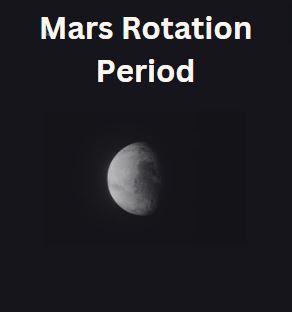Mars Rotation Period – Mars, the fourth planet in our solar system, is a barren and frigid desert with a sparse atmosphere. This active planet experiences seasonal changes, hosts polar ice caps, ancient volcanoes, deep canyons, and varying weather patterns.
Mars is among the most investigated celestial bodies in our solar system, being the sole planet where rovers have been dispatched to traverse the unfamiliar terrain.
Mars Rotation Period
NASA expeditions have uncovered ample proof that Mars was once wetter and hotter, boasting a denser atmosphere billions of years ago.
The Romans christened Mars after their god of war due to its reddish hue resembling blood. The Egyptians referred to it as “Her Desher,” translating to “the red one.”
To this day, Mars is commonly denoted as the “Red Planet” because of the oxidation of iron minerals in Martian soil, giving rise to a red appearance on the surface.
Understanding Mars Rotation Period
Mars, the fourth planet from the Sun, has a rotation period that has intrigued scientists and space enthusiasts for decades. The rotation period of Mars refers to the time it takes for the planet to complete one full rotation on its axis. Unlike Earth, which takes approximately 24 hours to complete a rotation, Mars has a slightly longer day, lasting about 24 hours and 37 minutes. This subtle difference in rotation periods can have significant implications for the planet’s climate, weather patterns, and overall geology.
Factors Influencing Mars Rotation Period
Several factors influence the rotation period of Mars, including its distance from the Sun, axial tilt, and composition. Mars’s elliptical orbit around the Sun causes variations in its rotational speed, leading to seasonal changes and fluctuations in day length. The planet’s axial tilt, similar to Earth’s, also plays a crucial role in determining its rotation period and the distribution of sunlight across its surface. Additionally, the composition of Mars, including its thin atmosphere and lack of large bodies of water, can affect its rotational dynamics.
The Romans named Mars after their god of war due to its reddish hue resembling blood. Similarly, the Egyptians referred to it as “Her Desher,” translating to “the red one.”
Today, it remains commonly known as the “Red Planet” as a result of iron minerals in its soil oxidizing and giving it a red appearance.
Scientists do not anticipate discovering current life forms on Mars but are instead searching for evidence of past life during periods when the planet was warmer and had water.
Size and Distance – Mars Rotation Period
Mars has a radius of 2,106 miles (3,390 kilometers), making it approximately half the size of Earth. To put it into perspective, if Earth were the size of a nickel, Mars would be comparable in size to a raspberry.
Mars orbits the Sun at an average distance of 142 million miles (228 million kilometers), which is equivalent to 1.5 astronomical units (AU). An astronomical unit (AU) is the distance between the Sun and Earth, and at this distance, sunlight takes 13 minutes to reach Mars from the Sun.
Rotation and Orbit – Mars Rotation Period
Mars completes one rotation around the Sun every 24.6 hours, akin to Earth’s 23.9-hour day. Days on Mars are referred to as sols, derived from “solar day.” A Martian year spans 669.6 sols, equivalent to 687 Earth days. Mars’ axis is tilted 25 degrees concerning its orbit plane, similar to Earth’s 23.4-degree tilt. Like Earth, Mars experiences distinct seasons, but they are lengthier due to its longer orbit around the Sun.
Unlike Earth’s evenly distributed 3-month seasons, Mars’ elliptical orbit causes varying season lengths. Spring in the northern hemisphere (autumn in the southern) lasts 194 sols, making it the longest season.
Autumn in the northern hemisphere (spring in the southern) is the shortest at 142 sols. Northern winter/southern summer lasts 154 sols, while northern summer/southern winter endures 178 sols.
Mars Atmosphere – Mars Rotation Period
Mars has a sparse atmosphere primarily composed of carbon dioxide, nitrogen, and argon gases, resulting in a hazy red sky due to suspended dust. This differs from the blue hue seen in Earth’s sky.
The thin atmosphere provides little protection against impacts from meteorites, asteroids, and comets. Temperatures on Mars range from a high of 70 degrees Fahrenheit (20 degrees Celsius) to a low of approximately -225 degrees Fahrenheit (-153 degrees Celsius).
Due to the thin atmosphere, heat easily escapes the planet. Standing on Mars’ equatorial surface at noon would yield a spring-like temperature at your feet (75 degrees Fahrenheit or 24 degrees Celsius) and winter-like temperatures at your head (32 degrees Fahrenheit or 0 degrees Celsius).
Periodically, strong winds generate dust storms that engulf a significant portion of Mars. It may take months for all the dust to settle after such storms.
Thanks for Reading “Mars Rotation Period”.

Leave a Reply